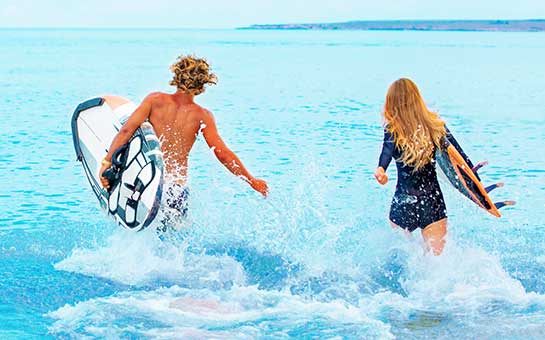Looking for the best travel insurance for surfers? Surfing is one of the most popular adventure sports, and it draws thousands of surf enthusiasts to world-renowned beaches like Bali and Hawaii every year. Like all adventure sports, however, there is a certain amount of risk involved. The dangers are real, and it’s important to take steps to protect yourself accordingly. If you are going surfing on your vacation, add a financial buffer with surfing travel insurance to cover yourself for any eventuality.
Travel Insurance for Surfing
Getting travel insurance for surfing minimizes the financial risks associated with hazardous sports. Medical bills for extreme sports injuries are massive in most countries. Extreme-sports travel insurance can save you from such expenses.
A comprehensive extreme sports travel insurance plan for surfing will also come into play if your surfboard gets damaged or stolen. The peace of mind provided by insurance is worth much more than the cost of a new surfboard. Be aware that a standard travel insurance plan will not cover the risks of surfing, so make sure to purchase surfing travel insurance before you head out to sea.
Basics of Surfing
Surfing is a water sport and has been around for more than a century. It's the art of catching breaking waves and riding them to shore on a surfboard. As a general rule of thumb, modern surfboards are made of polyurethane and fiberglass. They are about six feet long, 18 inches wide, 2 inches thick, and often as light as 5.5 pounds (about 2.4 kilograms).
The addition of three fins to the surfboards made them more maneuverable, turning the adventure sport into a ballet among the waves. Experienced surfers often perform spectacular stunts such as “tailslides” (letting the board slip down the face of the wave by pulling up the fins), “floaters” (floating the board across the crest), “reverses” (rapidly changing direction), and “360s” (spinning the board 360 degrees on the face of the wave).
Most recreational surfers are content to paddle up to a wave and catch it as it crests. But the true glory of the surfing community is to slide through the “tube” as the wave arches over and collapses behind you. Surfers often describe their time inside that tunnel of water as an otherworldly and spiritual experience. This does, however, considerably increase the risk of a “wipeout”, or crash.
The adrenaline rush of riding a wave can be a heady intoxication. The bigger the wave, the headier the rush. But before you go hunting for waves, you need to plan out some safety measures, as the sea can be very unforgiving. Hazardous sports travel insurance can act as a failsafe against such risks.
Risks of Surfing
Like any other adventure sport, the thrill of surfing comes with risks. Safety standards are constantly being updated, including better equipment and highly trained lifeguards who stand by in case of an accident. But surfing can never be entirely risk-free because of the unpredictable nature of the sea.
Always perform recreational surfing under expert guidance and under mild weather conditions. Large waves can cause severe damage to both your body and equipment if you make a mistake while out on the water. Getting a surfing travel insurance plan before your board hits the water will definitely help ease your mind.
